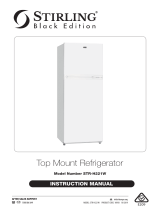
1
Contents
Important Safety Instructions_ _ _ __1
Installation_ _ _ _ _ _ _ __ _ _ _ _ __ _3
Appliance Description _ _ __ _ _ _ _ _4
Temperature Control_ _ _ _ _ _ _ _ __ 6
Cleaning and care_ _ _ _ _ _ _ _ _ __ _8
Energy Saving Tips_ _ _ _ _ _ _ _ _ _ _10
Trouble Shooting_ _ _ _ __ _ _ __ _ _ _10
Important Safety Instructions
For your safety and correct usage,
please read these instructions carefully
before using your new appliance to
avoid unnecessary mistakes and
accidents. Please ensure that all
people using this appliance are familiar
with its operation and safety features.
Keep these instructions in a safe place
for future reference and be sure that
they are kept with the appliance in the
event that it is moved or sold, so that
everyone using it through its life will be
properly informed on its correct
appliance usage and safety. The
manufacturer is not responsible for
damages caused by misuse. The
appliance is for indoor and domestic
use only.
Electrical Information
●
The appliance must be plugged into
its own dedicated 115 Volt, 60 Hz.,
15 Amp, AC only electrical outlet.
The power cord of the appliance is
equipped with a three-prong
grounding plug for your protection
against electrical shock hazards. It
must be plugged directly into a
properly grounded three prong
receptacle. The receptacle must be
installed in accordance with local
codes and ordinances. Consult a
qualified electrician. Avoid
connecting refrigerator to a Ground
Fault Interruptor (GFI) circuit. Do
not use an extension cord or
adapter plug.
●
If the power cord is damaged, it
should be replaced by an
authorized service technician to
prevent any risk.
●
Never unplug the refrigerator by
pulling on the power cord. Always
grip the plug firmly, and pull
straight out from the receptacle to
prevent damaging the power cord.
●
Unplug the refrigerator before
cleaning and before replacing a
light bulb to avoid electrical shock.
●
Performance may be affected if the
voltage varies by 10% or more.
Such damage is not covered under
your warranty.
●
Do not plug the unit into an




















